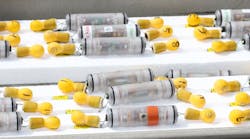Biologists and environmental researchers will put hundreds of robotic “fish” to work at dams around the world—the result of an agreement between the company that makes them, Advanced Telemetry Systems, and the Dept of Energy’s Pacific Northwest National Laboratory. The goal is to determine what happens to fish as they pass through the dam’s water and turbines.
The Shish Sensor was developed at PNNL to monitor and transmit what happens to fish as they pass through turbulent waters and turbines at hydroelectric facilities. The Sensor Fish is a small autonomous device filled with sensors that analyze the physical stressors fish experience when passing through or around dams.
The sensors provide researchers with accurate physical measurements such as acceleration, pressure, rotational velocity, and orientation, all of which convey what real fish experience during downstream passages. Each sensor provides roughly 2,000 measurements per second and typically takes less than two minutes to pass through the dam due to the water’s velocity.
“The vast majority of juvenile salmon and steelhead passing through the turbines survive without injury in the Columbia River Basin,” says Daniel Deng, a laboratory fellow at PNNL. “Still, we want to understand more about the injuries and mortality that do occur from abrupt pressure changes in dam turbine chambers. The Sensor Fish will provide information to help engineers design more fish-friendly turbines going forward.”
Once the Sensor Fish comes out on the other side of the dam, an automatic retrieval feature brings it to the surface. Radio signals and flashing LEDs on the Sensor Fish enable them to be collected quickly from boats stationed nearby.
The Sensor Fish has demonstrated its value in many field studies, for which Deng’s team has built individual Sensor Fish in its lab at PNNL. Now, with the technology licensed to ATS, the manufacturing process can be streamlined so more hydropower operators and researchers will be able use them.
“There is a big need for the type of data provided by the Sensor Fish,” says ATS president Peter Kuechle. “Mature hydropower industries in the U.S. and Europe hope to modify operations to help fish survive. In Europe, regulations insist on testing for this information, and certainly there’s a need for the data in emerging hydropower projects globally.”
ATS has also licensed two other fish technologies developed at PNNL. The Juvenile Salmon Acoustic Telemetry System (JSATS) and its advanced decoder software can track fish passing through dams and beyond and monitor fish behavior. PNNL developed the JSATS transmitters and battery to be so small it can be injected into young fish. This eliminates the need to surgically implant a tag, which puts extra stress on a fish. JSATS includes the smallest acoustic transmitters in the world.
PNNL has also recently developed an even smaller tag that can be used on the tiniest fish, including juvenile eel and lamprey. “This new acoustic fish tag meets the Army Corps of Engineers’ JSATS specifications and weighs less than 0.01 oz.,” says Kuechle. “JSATS is complementary to our long history of developing innovative and cost-effective wildlife tracking products.” PNNL is now working to develop a self-powered tag for long-term monitoring.

